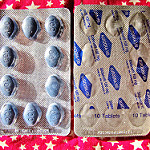A lot of press has been given to the FDA Approval of flibanserin or Addyi, marketed as the “Female Viagara” by the media in the last few months and I wanted to briefly weigh in on my thoughts about this pharmaceutical.
First, flibanserin really isn’t the “female viagara” as Viagara for men works with the arousal system of a male (helping a client to keep and maintain an erection). Flibanserin actually has been promoted to address female sexual desire, not arousal, so the nickname isn’t really suited. Although I wouldn’t recommend promoting this, if we wanted to come up with a more accurate nickname for flibanserin, “pharmaceutical foreplay” might be more appropriate… (please don’t publish that or quote me on that!)
Second, there has been a lot of concern about the negative side effects and possible harmful side effects of this medication. I’m not going to really take a stance on that because every medication ever invented has negative side effects and when a physician makes the decision to prescribe a medication to their patient, they do so hopefully knowing and hopefully being fully aware of the side effects and have made the decision to prescribe this drug, because they believe that the BENEFIT outweighs the RISK to the patient. All drugs have side effects, some positive, but many negative or harmful. What I will say, is that doctors are NOTORIOUS for not going over the side effects of medications (or not being aware of the side effects) so this is something I am going to be firm on. Don’t rely on your doctors to go over this with you- be your own advocate and research the side effects and know what you are taking. Track those side effects over a period of time and be aware of what you can and can not tolerate. Track the positive benefits as well- you don’t want to be taking a drug that doesn’t work or does more harm than good. And clinicians, take the time to go over the side effects with your clients as well. It might save everyone a lot of time and effort around treatment if everyone is informed.
Third, my main issue with flibanserin is the same issue I have for all pharmaceuticals prescribed that aim to address a sexual issue: if the mechanism of change is not targeted at the reason for the problem, the drug will likely not be effective. Taking a pill, that is supposed to fix your issue, and then when it doesn’t, can just REINFORCE the problem. A failed attempt at solution can often just be more fuel to the fire of the problem.
I’ll demonstrate:
I guest lectured at St. Edwards University in Austin, TX in a graduate-level counseling and marriage and family therapy course and we were discussing the diagnosis, assessment, and treatment planning for sexual dysfunctions. I asked the class to pick a sexual issue that a client might present with for therapy. The class chose one of the most common sexual dysfunctions: low sexual desire in females. The next activity I had them do is to come up with all the reasons why a woman might have low sexual desire or low libido. Here is the list they came up with (in no particular order):
Depression
Anxiety
Low Sexual Self Confidence
Religious Concerns
Cultural Concerns
Medication Side Effects
Communication Issues in the Relationship
Communication Issues about Sex
Sexual Orientation Issues
Gender Identity Issues
Body Image Issues
Stress
Not Enough Time
The Sex Isn’t Good
Lack of Creativity or Novelty in Sex
Pain or Discomfort
Illness
Post-Traumatic Stress Disorder
Lack of Pleasure In Sex (no orgasm)
Dysfunctional Meaning of Sex
Fertility/Hormone Issues
Feeling Pressured to Have Sex
Lack of Foreplay
These are all causes of low libido or low sexual desire or female hypoactive sexual desire disorder (as according to the DSM-V). Flibanserin doesn’t say that they treat ANY OF THE ABOVE ISSUES, so then, readers, can you see how this drug might not be that effective if it DOESN’T TREAT THE ROOT CAUSE OR CAUSES OF THE ACTUAL LOW DESIRE! So, I am sure you can understand that if depression is one of the main contributing factors to low desire, and a woman takes flibanserin to increase desire, it might not work. And if it doesn’t work, how do you think that “failure” of that specific intervention might contribute the main contributing factor of depression. It would likely increase it!
Fourth, and final, thing I would like to say about this drug. I am a firm believer of having a lot of different tools in your toolbox for your issues. And I am also a believer that you can never have enough tools- in life and in your “real” toolbox! So I support flibanserin as a tool in our toolboxes to treat low desire. However, just as you wouldn’t use a screwdriver to hammer in a nail, you wouldn’t use flibanserin to resolve low desire if that isn’t the tool you need. How do you decide which tool you need? That is a great question to answer in collaboration with a qualified and certified sex therapist.
I am choosing intentionally not to mention anything about the “equality” of having a drug for women that addresses sexual functioning. The makers of flibanserin started a “Even the Score” Campaign in efforts to rally support around the FDA-approval and subsequent manufacturing and sale of the drug. The idea was that it is only “fair” and “equal” if women have a drug to address sexual functioning just like the men (amongst other ideas). The only thing I will say about that is that as soon as you start keeping score with something, everyone has already lost. There are no winners.
If you are struggling with low desire, low libido, hypoactive sexual desire disorder, whether male or female, I can help.


